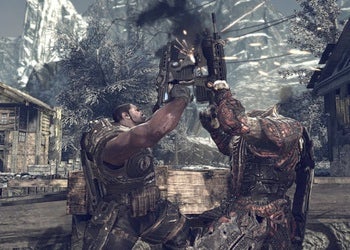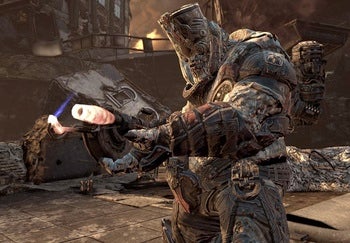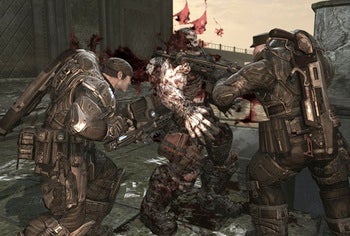When Epic's design team was prodded about Gears of War 2's story in interviews earlier this year, it boasted that the sequel to its mega-selling third-person tactical shooter would have more heart. They weren't kidding. Gears 2 has all kinds of heart, only not for the reasons you're probably thinking. Let's just say you wouldn't mistake this skillfully paced and obsessively detailed game's cranked up cardiac fetish for the double-humped icon etched on greeting cards or at the end of junior high love letters. In Gears 2, it's the bloody pumping organ itself, all veins and striated muscle, a mentally grinding, athletically pounding assault on your senses without a delicate Hallmark moment in sight. Red meat for the twitching masses. Halo for the shoot-and-swagger crowd.
I'm talking mostly about the story, of course, effectively MIA from Gears of War, and long rumored to be "deeper" this time around. In July, Carlos Ferro, the actor who voices Dominic Santiago (one of your squad mates in the game) went so far as to claim Gears 2 would be "more emotionally affecting" than Irrational's BioShock, a game often celebrated for its unusual thematic maturity. Ferro's comments left diehard fans breathless but the rest of us frankly bewildered. The original Gears was dark and despairing, sure, but if it ever had a sensitive side, someone took a chainsaw to it long ago. Besides, "Story, schmory," said fans, and "We wanna shoot some cool stuff."
"Yes You Can!"
Don't worry, there's if anything probably twice as much cool stuff to power-drill here. And while there is an uptick in Gears 2's steel-ribbed, gun-rocked melodrama, it's tale of humanity's apocalyptic war with a subterranean species known as the Locust Horde is still mostly pulp fiction about guys with arms like tree trunks and shoulders up to their eyeballs who affectionately bump rifles in lieu of chests. Guys who share quips like locker room jocks fantasizing about ways to pound the other sides' tackles and tight ends and tailbacks into meat pudding. Guys who don't mind offending the ladies (who aren't really in the game, but might be watching their husbands and boyfriends playing it) with occasionally crude, boorish references.
At one point in Gears 2, the driver of a vehicle that looks like the Sandcrawler in Star Wars, a guy who sports a cowboy hat and speaks with an exaggerated twang, refers to the dual lights on his vehicle as a pair of "rhymes-with-ditties." Guys in the room may chuckle, girls in earshot will probably cringe. And when the moment that Ferro was actually referring to finally arrives, it really is moving, but then it's in spite of the narrative remainder's dramatic ticks, which have all the emotional resonance of gongs struck with sledgehammers.
"Who cares," you're saying, "just tell me whether Gears 2 is a better game!"

It is, for the most part. It's still the same game, mind you, but with less of the first one's problems. You still play as a guy who rasps like a three-pack-a-day smoker, jogging with small squads of three or four through cover-cluttered environments scrambling for places to conceal your considerable bulk. You still hunker in the ruin of human cities and hump wrecked cars or bullet-chiseled concrete walls by tapping a button, peering around corners to unload ammo clips or snipe off heads poked unwisely over barriers. You still have to stare across areas crosscut by tracer fire and figure out the best way to liquefy a clutch of dug-in enemies by flushing them out with pincer fire.
In the ominous interludes between battles, you'll scout the debris for new weapons or hunks of ammo and the rare bit of background material in the form of dog tags, inscribed messages, and scraps of paper. Then it's back to work, squatting behind whatever you can scrabble over to, popping up, scanning for shots, sliding along your plane of protection to change your angle on the battle, flanking where possible, ensuring you're not outflanked in the process. It's a tense and tactically delicate experience, more "crawl and brawl" than "run and gun."
The first Gears frequently dispatched you down not-so-invisible highways with arbitrarily concocted encounters that triggered only after you tripped phantom wires. It's broadest spaces looked wide open but often felt functionally claustrophobic. Assaults on enemy positions often had a meat-and-potatoes "straight" route next to a heinously flagrant "sidewise" alternative. While its multiplayer levels were designed to let you get behind your enemies with a little cautious maneuvering, in solo play, the enemy never really tried to circle round you.
The game's five act campaign consequently felt more like clawing your way along a heavily defended tunnel. The upside was that it still took plenty of skill to move forward, enough that you often didn't notice the tunnel's walls. The downside was that things never felt as laterally tactical as they should have, something a lot of critics missed, or simply misunderstood.
Sharper Enemies, Smarter Pacing
Gears 2 still portions itself into acts and those acts into chapters and the chapters themselves into micro-tactical objectives, but the places you'll go feel more explorative and far less restrictive this time. From the flame-licked wreckage of human cities to the stunning fungoid beauty of the subterranean Locust hollow here, most areas are simply bigger, with more cover to cling to (and in a few intriguing cases, nubs of cover you can conjure up yourself). Structures or underground tunnels now tend to have multiple ingress and egress points, and choosing alternative routes extends well beyond the three or four scripted moments that Gears 2 pauses like its predecessor and asks you to choose a road, high or low.

The enemy better understands how to take advantage of those routes, too, something that's especially obvious in the game's new multiplayer "Horde" mode, where the computer fiendishly throws up to 50 waves of increasingly powerful enemies at you. Every 10 waves you make it past, those enemies dish out and soak up more damage, and without a solid group, they'll lay you out in less time than it takes to pull off a perfect reload.
Incidentally, it's worth dying on purpose in "Horde," because you can pull back and watch what's happening with handy text tags identifying the bad guys by name (as in their functions, like "grind," "boom," and "burn" -- guess what they do). Observing Gears 2's new-and-improved enemy quickly and intelligently advancing to flank or SWAT-style assault your pals is both illuminating and chilling. Spend some time here. You'll learn a lot.
Epic seems to have a better handle on the game's pacing this time, too, intercutting battles with combat-free sections that give you a chance to simply pan and scan the eye-catching architecture or take a moment to reflect on the drama. Other times, after pounding through occasionally grueling sections that'll see you dying and reloading lots -- like one particularly inspired level where razor-sharp hail pours from the sky as you volley with Locust troops and try to navigate forward without leaving overhead cover -- the game will suddenly drop you into a vehicle with devastating weaponry and give you some space to blink and stretch and pour that pressure-cooked stress into swarms of easily eviscerated enemies. It's simple and perhaps a trifle juvenile, but cathartic and purposeful and evidence of solid game design at work.
Super Gears Bros.
Not that the game's any easier for those moments. If anything, it's more challenging for the reasons listed above, but on occasion for a few bad ones as well. There's a maddeningly clumsy flying sequence toward the end, for instance, where you have to man a pair of mounted guns, switching between fore and aft. That in itself isn't a problem, but the game -- which until this point has seen you on flat surfaces rarely shooting more than 45-degrees off dead center -- hasn't prepared you for 360-degree aiming, not to mention simultaneously dodging lethal incoming objects that can take you out in a blink. It's a gaping design flaw, exacerbated by the fact that you're playing a detestable memorization game: Fly to a spot, die, realize what you need to do not to, inch forward to the next death, bookmark the workaround, repeat until you're through. Does it look cool? Heck yes, but you're too busy fighting the controls and mucking them up and, you know, dying and reloading to frankly care.

Other issues are notable but not game-breaking. Enemies sometimes fail to acknowledge your presence standing a body length or two over, or step out stupidly from cover into a blizzard of gunfire. You could argue that makes things more realistic, more reflective of the kinds of mistakes humans make in multiplayer, but I doubt it's intentional. There's also a sequence toward the game's middle that celebrates design lead Cliff Bleszinski's love for Shigeru Miyamoto. It's relatively inoffensive, probably because the running and dodging parts are easy to breeze through and over quickly enough. Most players will remember it long after they've set the game aside, but for entirely different reasons.
Submit, Wingman
I've already mentioned "Horde" mode in multiplayer games, but of all the kill-or-be-killed competitive variants here, the brightest are probably "Submission" and "Wingman." "Submission" looks like capture the flag, except the flag has arms, legs, and a gun. He's also referred to as a "meat flag," and the idea's to capture him as an enemy shield, hostage style (a feature in the campaign as well, but one I found functionally useless, for the record) then drag him into a ring. Hold inside the ring long enough and your team wins.
"Wingman" pits you and an identical-looking teammate against four additional two-player teams in kill contests with high stakes rules: to kill an opponent, you have to execute a close range maneuver or score a one-shot kill. It's an incredibly tense game of hobble-then-pounce that gets players out of a map's corners and hide spaces and taking chances in closer quarters.

Join or leave anytime cooperative play is back, online or off, and continues to work so well it makes you want to wag your finger at other games that "break" their campaigns or cripple their stories when folding partner players in. Yep, you can still convert a single player game into a coop one or vice versa, which makes you wonder why Epic even bothered splitting the two apart, since it would have been just as easy to add a "solo" option to coop mode's "private" or "public" Xbox Live invite tags.
Up Your Arsenal
Favorite new weapons? Nothing stands out. I'm a rifle and sniper guy most of the time, but occasionally tapped the new flamethrower to fend off enemies in a few sections where they crowd-rush you (the ability to flame out farther each time you hit a perfect active reload is especially satisfying). The ink grenades which kick up a poison cloud are helpful if you want to flush someone out, since the area effect is broader than the blast radius on frags. A few spots let you wield a mortar cannon, which fires imprecisely, precisely as it should, and rewards firing off a few test shots by giving you a better sense for how your button timing relates to casting distance.
The most helpful new weapon, especially towards the end, is probably the boomshield, which you hold in your left hand while wielding a pistol in the other. Employing the shield acts like cover, but lets you advance slowly forward, allowing bold angles on entrenched enemies and giving you forward momentum since you can march and shoot simultaneously. It's also possible to plant the shield and hunker behind it, though it's a tactic I've yet to find useful.
"Die, Oo-mahn!"
Gears of War 2 isn't for the fainthearted or easily frustrated. It's also still more a divider than a uniter. It's not dramatically interesting enough to medicate anyone deathly allergic to shooters, and given its hardcore demographic, not really friendly enough online to appeal to the only casually competitive. But for a series that's already sold millions of copies, those were always the outliers anyway. If you're a Gears fan, Gears 2 is all steps forward, a game that played at the highest difficulty levels constantly teases "Bet you can't." To which the only proper response is "Just watch me."


No comments:
Post a Comment